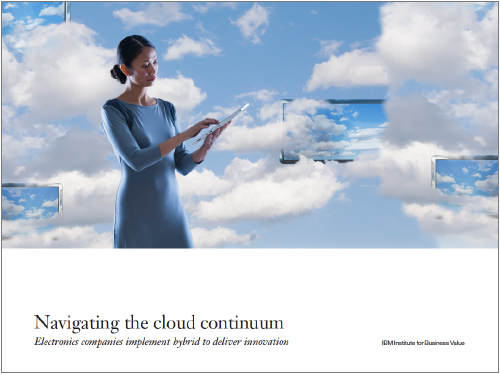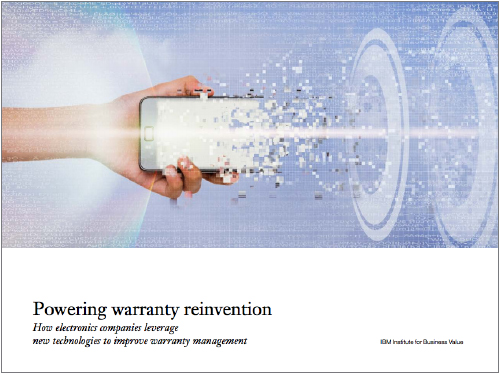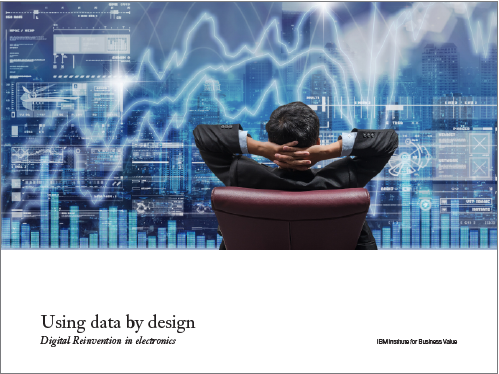Starting this week, the newest gadgets will glisten in all their glory at CES in Las Vegas.
While the latest curved TV is beautiful, the IBM Institute for Business Value would like to focus on strategies that can help your business before your feed is filled with shiny objects.
We have one of the richest global research data sets developed in electronics. It monitors the pulse of the industry and tracks transformation while taking into account economics, investment metrics and the sources of early returns. From our research, we’ve identified seven initial insights electronics executives should consider to help increase organizational intelligence, innovation, relevance and resilience:
Cloud is no longer an IT thing. Cloud is an innovation thing.
Organizations need to adopt different metrics to measure and capitalize on its power. While 56% of electronics executives plan to continue investments in cloud computing, advanced companies will be navigating the cloud continuum to deliver innovation. Using cloud to spread the workload or speed of new product development or reinventing the supply chain with external data, a new approach will focus on business value; data combined from public and private data sets; speed to answer and use that that data; and security. Our new report presents eight use cases that thoughtfully weigh business objectives to achieve innovation.
Merging Internet of Things (IoT) and artificial intelligence (AI) technologies is a fast path to value.
Starting with two or three use cases and a firm strategy is critical. While the rush to install IoT sensors has yielded success, there’s so much more you could know and can do. In electronics, an amazing 90% of respondents are experimenting, piloting, implementing or have established an IoT beachhead in the market. A set of early adopters has found success because of their strong ties to strategy.
Overall, 42% of electronics respondents said they expect the combination of IoT and AI to transform their businesses. Using IoT data for base use cases — such as detect and repair — is a great starting point. However, combining IoT with multiple external data sources leveraging AI has more significant value. Mapping device locations to enable better technician routing, understanding water quality or power supply considerations, and assessing geo-based impacts or temperature considerations leads to better, more rapid decisions. It leads to better warranty management and product decisions.
Electronics executives say they expect to have more ecosystem partners and better sharing, yet we’re still saying innovation is coming from inside the organization.
That thinking has to change. To talk about convergence in real terms, let’s consider these five data points:
Of the electronics executives we surveyed,
- 77% said they expect to defend their current market position through price and cost reduction.
- 73% said that industry incumbents are deploying innovative technologies, processes or business models.
- 71% said they expect to expand ecosystem partners and engage in better sharing.
- 73% also said convergence (the merging of industries, as suppliers, distributors, customers and competitors increasingly cooperate in ecosystems created to deliver new products and services) was the greatest trend they see driving the business.
- Yet 50% said they expect their innovation to come more from internal sources than form external ones.
Does it strike anyone else that these illustrate conflicting purposes? Companies are fully capable of Digital Reinvention® and greater reliance on partners to do what they do best as a faster path to success. Yet some companies rely on price- and cost-reduction for market manipulation. That’s a race to the bottom. No matter how effective your supply chain, neither price- nor cost-reduction builds the trust or loyalty customers require in an increasingly digital world.
Digital Reinvention® is not a feature set, it’s a methodology and a mindset.
Digital innovators are identifying opportunities in traditional and emerging electronics markets, where they successfully blend equipment, software, services and content into powerful packages. It is a re-imagining of how business is done. By design, it centers on outcomes rather than inputs and starts with the future rather than the present or past. It helps electronics businesses re-conceive how and with whom they operate and how they engage with their environment. And it helps them better understand the imperatives of their consumers, customers and business partners — which helps them anticipate rather than respond to needs. Shifting away from a product-centered focus to an experience-centered one is key. We have seven examples in a new report, with more to come.
Adaptability is now a mission-critical skill, and it requires a platform.
Electronics businesses can’t depend on one product or even multiple products capturing sufficient market share to drive their aggressive growth targets. That’s what makes adaptability and resilience so valuable, along with innovation and intelligence. Platforms enable intelligence accessible to the organization — going well beyond mobility to increase collaboration. That support massively increases connections and networking of data and people.
In this area, AI is simply the only way to bring together the disparate but important facts an electronics company will need to scale up or down in the right areas — whether that’s capacity, product, resources or capital. You can’t be fast or fluid enough any other way.
The platform should be all about data. The data economy is not “the new oil,” it’s the means to change the scope and scale of your business.
The primary function of a platform should be to enable Digital Reinvention®. This can allow companies to focus on the creation of a data economy to serve customers and ecosystem partners. It accords data a role central to every part of the business, allowing organizations to change both scope and scale quickly.
You will need to consider three core sets of data: people data, asset data and environment data. This data should come from inside and outside your organization. That is why Digital Reinvention focuses on outcomes. Solving your biggest challenges and creating your biggest opportunities requires context from the world at large.
There’s a connection between devices, privacy and consumer expectations that sets up better ways to win.
This adds up to an ocean of data — from devices and actions to consumers and processes. All of those have security and privacy implications that are growing increasingly complex.
The sharing population has distinct expectations around trust, transparency and value. According to new IBV research on data-sharing, 72% of respondents said they were sensitive to the way electronics companies handle their information and 80% indicated privacy was important compared to other topics. And of those most willing to share their information, 79% said the data they provide belongs to them. The most advanced organizations understand this. When we asked electronics executives about the importance of data security and privacy of a customer’s private data, 72% said it was mission critical. We can expect customers are going to ask them to prove it.
Want to learn more? IBM’s bench strength, solutions portfolio and industry experts are ready in Las Vegas this week for you to come talk to us. Drop in and say hi. We have plenty to talk about.
Meet the author





